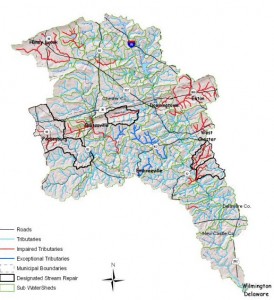Plan calls for towns to work together to meet complicated EPA mandates
By Mike McGann, Editor, UnionvilleTimes.com

The watershed in the Unionville area is a complex maze of creeks and streams feeding the local acquifer, as well as for communities to the south.
POCOPSON — Unlike Las Vegas, what happens in Honey Brook apparently doesn’t stay in Honey Brook — at least when it comes to storm water runoff and sediment.
That’s why the township Board of Supervisors voted Monday night to join an effort led by the Brandywine Valley Association for towns to work together to meet mandates from the federal Environmental Protection Agency and the state Department of Environmental Protection to reduce the amount of sediment running into the Brandywine, Red Clay and White Clay creeks.
According to the BVA’s Jane Fava, who spoke at Monday night’s meeting, the EPA is imposing regulations on how much sediment can find its way into local water ways, as the sediment is causing problems downstream, in Wilmington, Del, where the water is the city’s drinking water source, and ultimately throughout the Chesapeake Watershed — and bacterial load from farming upstream is a problem. But the sediment itself is a problem, causing flooding in parts of Delaware County and further south, as soils and other materials carried down stream build up.
“You can spend an awful lot of money on this without accomplishing much,” she told the supervisors. “If we work together, we have the power to manage this on a more reasonable basis.” She noted that BVA is able to raise private money to help with the effort, something local municipalities cannot do.
Initially, supervisors seemed a bit skeptical of the idea, for which the township will need to spend a minimum of $2,000 between this year and next year.
“I’m a little worried that it could set the township back if the programs,” supervisor Lauressa McNemar said. She said she’s like to see DEP endorse the concept in writing. Fava said that while DEP officials have spoken well of the idea, they probably would not be willing to put any sort of endorsement in writing.
Both she and Supervisors chair Steve Conary noted that the township has little in the way of financial resources to meet another unfunded mandate.
“The EPA and DEP don’t care that you don’t have any money,” Fava told them.
The township will be required to identify five potential sediment reduction projects and complete two in the coming years. Some could be as simple as planting trees along the Brandywine, which has already been done in a number of areas, to reduce erosion. More complicated, and expensive, options may have to be looked at down the road, including buying easements from local dairy farmers to keep their cows further way from streams.
More than a dozen local towns have agreed, Fava said, either in principle or by formal vote, as Pocopson has, to join the effort, including Honey Brook, London Grove, East and West Brandywine and East and West Bradford. She said the goal is to get 20 to 25 of the 40 towns hit by the EPA standards to join the effort.
Fava, who coordinates the Red Streams Blue program for the BVA, told supervisors Monday night that EPA is going to force local towns to address the issue — a challenge in a state like Pennsylvania, with limited regional management resources. Without working together, Fava said, it would be very difficult for local towns to meet their EPA requires to cut sediment discharge into local streams.






